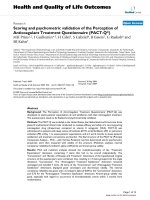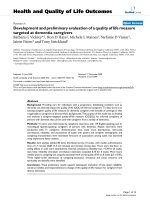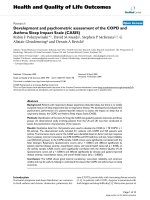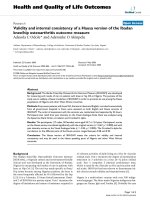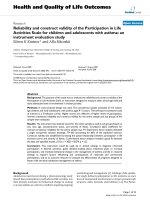Báo cáo hóa học: "Synthesis and Spectral Studies of CdTe–Dendrimer Conjugates" docx
Bạn đang xem bản rút gọn của tài liệu. Xem và tải ngay bản đầy đủ của tài liệu tại đây (327.22 KB, 5 trang )
NANO EXPRESS
Synthesis and Spectral Studies of CdTe–Dendrimer Conjugates
Srabanti Ghosh Æ Abhijit Saha
Received: 1 April 2009 / Accepted: 5 May 2009 /Published online: 22 May 2009
Ó to the authors 2009
Abstract In order to couple high cellular uptake and target
specificity of dendrimer molecule with excellent optical
properties of semiconductor nanoparticles, the interaction
of cysteine-capped CdTe quantum dots with dendrimer
was investigated through spectroscopic techniques. NH
2
-
terminated dendrimer molecule quenched the photolumi-
nescence of CdTe quantum dots. The binding constants and
binding capacity were calculated, and the nature of binding
was found to be noncovalent. Significant decrease in lumi-
nescence intensity of CdTe quantum dots owing to nonco-
valent binding with dendrimer limits further utilization of
these nanoassemblies. Hence, an attempt is made, for the first
time, to synthesize stable, highly luminescent, covalently
linked CdTe–Dendrimer conjugate in aqueous medium
using glutaric dialdehyde (G) linker. Conjugate has been
characterized through Fourier transform infrared spectros-
copy and transmission electron microscopy. In this strategy,
photoluminescence quantum efficiency of CdTe quantum
dots with narrow emission bandwidths remained unaffected
after formation of the conjugate.
Keywords Quantum dots Á Dendrimer Á Conjugate Á
Infrared spectroscopy Á Luminescence
Introduction
Rapid advances in nanotechnology and nanoscience have
spurred interests in developing a variety of nanostructured
materials. In this context, semiconductor nanoparticles (also
known as quantum dots) are the most promising ones due to
their high photochemical stability and size-tunable photo-
luminescence [1]. Quantum dots (QDs), in particular, have
potential applications in optoelectronics, biosensing and
biolabelling, etc. [2, 3] Recently, integration of these QDs
with biological macromolecules greatly expands the impact
of optical imaging, sensing and also of therapeutic strate-
gies [4, 5]. The binding of different categories of molecules
to QDs has been studied by optical methods to elucidate
binding mechanism, because the surface of nanoparticles
(NPs) affects the electronic states, which, in turn, influence
the photoluminescence (PL) emission of QDs [6]. In our
earlier reports, the binding of amino acids, DNA bases,
biological relevant metal ions, enzyme and peroxynitrite
(PN), a powerful biological oxidant with semiconductor
QDs was investigated, and a quantitative correlation was
established therein [7–11]. However, the binding of den-
drimer with QDs is of special interest as immobilization of
semiconductor nanocrystal onto dendrimer has great
implication in the field of material science in view of
amalgamation of excellent luminescent properties of
semiconductors with varied functionalities of dendrimer
molecules. PAMAM Dendrimers are synthetic spherical
macromolecules with a well-defined surface, comprising a
core, branching sites and a large number of terminal groups
[12]. The biomimetic properties and low cytotoxicity of
dendrimer molecules make them potentially useful for
many biological applications such as gene transfection,
diagnostics, drug delivery as well as nanoscale building
blocks [13, 14]. The molecules are small enough to pass into
the cell membrane and can be used to deliver substances
such as drugs, genetic materials or chemical markers right
into the cells [15]. Thus, CdTe–Dendrimer conjugates can
act as new luminescent multi-functional nanostructured
materials. To achieve binding specificity and targeting
S. Ghosh Á A. Saha (&)
UGC-DAE Consortium for Scientific Research, Kolkata Centre,
III/LB-8, Bidhannagar, Kolkata 700098, India
e-mail:
123
Nanoscale Res Lett (2009) 4:937–941
DOI 10.1007/s11671-009-9339-1
ability, QDs can be linked to monoclonal antibodies, pep-
tides, oligonucleotides, small inhibitor or hydrophilic seg-
ment (such as polyethylene glycol [PEG]). It is expected
that the self-assembly of the dendrimer molecules onto NPs
provide a route to modifying the NPs for targeted imaging
of cancer cells [16]. In general, assembly process of NPs
largely relies on noncovalent interactions. However, the
drawback is the inherent instability of these conjugates
under varied environmental parameters, such as low pH,
higher temperature, ionic strength, etc. Thus, an alternative
pragmatic approach to preparing QD assemblies is inter-
facing through covalent binding [8, 17, 18]. This method of
functionalizing QDs is simple and can avoid complicated
synthesis and characterization of the intermediate products
of QDs, when reactions are performed on the QD surfaces.
A number of reports have been published in which bio-
logical molecules have been attached onto the surface of
QDs. However, optimization of conjugation process is a
prerequisite for the use of QDs in biomedical applications.
In the present work, the interactions between CdTe QDs
and dendrimers of different generations have been studied
fluorimetrically. The binding constants K
SV
and K
b
and
binding stoichiometry of the complex (n) have been deter-
mined. Significant differences on the values of binding
constants for dendrimers of different generation suggest that
generation has strong influence upon the interaction between
CdTe QDs and dendrimer. We, further, demonstrate a simple
method of the preparation of CdTe–Dendrimer conjugates
through covalent binding using Glutaric dialdehyde (G)
linker and describe their optical properties. Semiconductor–
dendrimer conjugate, thus synthesized, represents a hybrid
material in which fluorescence of semiconductors convo-
lutes with the biomimetic properties of dendrimer, which is
ideally suited for various biomedical applications such as
fluorescence imaging and probing of biological systems.
Experimental
Materials
L-Cysteine hydrochlorides and cadmium nitrate tetrahy-
drate were purchased from Merck, Germany. The starburst
dendrimers (PAMAM) of generation 2.0, 4.0, 5.0 (NH
2
terminated) and glutaraldehyde were obtained from Sigma
Aldrich, Germany. Telluric acid (H
2
TeO
4
,2H
2
O) and
sodium borohydrate (NaBH
4
) were purchased from BDH.
Synthesis of CdTe Quantum Dots and CdTe–Dendrimer
Conjugate
CdTe QDs were synthesized following our method as
reported earlier [19, 20]. An aqueous solution of Cd
2?
ion
(4.68 9 10
-2
M) and L-cysteine (11.70 9 10
-2
M) was
prepared, and pH was adjusted to 11.2–11.8 (using Jenway
3345 ion meter). Then, NaHTe solution was added under
nitrogen atmosphere. The resultant solution was refluxed at
100 ° C. The as-prepared CdTe QD solutions were further
diluted 10 times, and concentrations were so chosen that
absorbance was kept \0.1 to avoid self-absorbance effects.
The aqueous solution of 3.47 9 10
-7
M PAMAM den-
drimer of Generation 2, 4 or 5 was prepared, and few
microlitres (10–50 lL) of these solutions were added to the
different sets of 3 mL solution of CdTe QDs. In a typical
synthesis of CdTe–Dendrimer conjugate, 3 mL aqueous
solution of CdTe NPs (5 9 10
-6
M) was mixed with
50 lL of glutaraldehyde (10% in water) and 1 mL den-
drimer (7.0 9 10
-6
M). The solution was allowed to react
at room temperature for 24 h and dialyzed against the
phosphate buffer.
Structural Characterization
UV-Vis absorption and photoluminescence (PL) spectra of
nanoparticles solution were recorded on Shimadzu
UV-1601PC and Perkin Elmer LS-55 luminescence spec-
trometer respectively. Size distribution of CdTe QDs was
determined by dynamic light scattering spectrophotometer
(Model DLS—nanoZS, Zetasizer, Nanoseries, Malvern
Instruments). Samples were filtered several times through a
0.22-lm Millipore membrane filter prior to recording
measurements. The Fourier transform infrared spectros-
copy (FTIR) spectra were recorded with Perkin Elmer,
Spectrum GX equipment using KBr pellet with a resolution
of 2 cm
-1
. Transmission electron microscopy (TEM) was
carried out on JEOL-2010 with acceleration voltage of
200 kV. A drop of as-prepared solution of CdTe–Dendrimer
conjugate was placed on a carbon-coated copper grid of
300 meshes and dried before putting it on to the TEM
sample chamber.
Results and Discussion
The as-synthesized CdTe QDs were stable and highly
luminescent [19]. The FWHM (full-width at half maxi-
mum) of the PL spectrum is 36 nm, which suggests narrow
size distribution. The average size of CdTe QDs was found
to be 3.2 nm as determined from TEM images, which is in
good agreement with the size (3.0 nm) determined from the
correlation of particle size and optical band gap. Further,
average size and size distribution of CdTe QDs obtained
from UV spectra and TEM image were also supported
by DLS histogram (d
av
= 3.4 nm with narrow size
distribution).
938 Nanoscale Res Lett (2009) 4:937–941
123
The interaction of dendrimer with these QDs was fol-
lowed by fluorescence spectroscopy. The fluorescence
intensity of QDs was quenched, and the plot of F
0
/F
against dendrimer concentration is linear (Fig. 1), which
follows Stern-Volmer relation (Eq. 1),
F
0
F
¼ 1 þ K
sv
½Dendrimerð1Þ
where F
0
and F are the fluorescence intensities QDs in the
absence and in the presence of quencher, K
SV
the Stern-
Volmer constant. Additionally, binding constant (K
b
) and
binding capacity (n) were evaluated following the method
of Tedesco et al. [21] (Eq. 2),
F
0
À F
F À F
1
¼
½Dendrimer
K
diss
n
ð2Þ
where F
?
is the intensity of QDs saturated with the
quencher. The binding constant K
b
is obtained by plotting
log (F
0
-F)/(F-F
?
) versus log [Dendrimer]. A typical plot
is shown in the inset of Fig. 1. The slope of the plot gives
the number of equivalent binding sites or binding capacity
(n). The value of log [Dendrimer] at log (F
0
-F)/(F-
F
?
) = 0 equals to logarithm of dissociate constant (K
diss
),
and the reciprocal of K
diss
is the binding constant (K
b
).
Both Stern-Volmer constants and binding constants were
found to increase with increasing dendrimer generation
(Table 1). With increasing dendrimer generation from 2 to
5, the quenching constant (K
SV
) increased by factor 20. The
number of surface amine groups increases linearly with
increasing dendrimer generation, and this results in
increased interaction of QDs with the higher generation
dendrimer. Similar studies, based on the formalism
presented here, have been successfully used to evaluate the
binding properties of nanoparticles to the biological mac-
romolecules [21, 22]. To establish nature of quenching, the
effects of ionic strength as well as solvent polarity (sol-
vents of different dielectric constants) on the quenching of
QDs by dendrimer have been studied. Solvents of different
dielectric constants were prepared by mixing methanol
(e = 33.0) and water (e = 80.1) in different proportions. If
electrostatic binding or charge transfer process is involved
in the interaction, the quenching constant should be
adversely affected by decreasing the polarity of the solvent
[23]. Hence, quenching of CdTe QDs by dendrimer has
been studied by changing the composition of the solvent.
With decrease in the polarity of mixed solvent, the Stern-
Volmer quenching constants decreased sharply (Table 2).
The observed trend indicates that charge transfer might
have occurred between CdTe QDs and dendrimer at the
excited state, since there was no change in ground-state
absorption spectrum of CdTe QDs in the presence of
dendrimer. Greater the polarity of the solvent, more stable
will be the product; hence, more quenching was observed
in aqueous solution. In the solvent of reduced polarity
(methanol), the charge transfer process gets hampered
showing lesser quenching. Thus, it can be inferred that
quenching is caused by the electrostatic interaction
between CdTe QDs and dendrimer.
Hence, efforts have been made to bind the dendrimer
molecules with QDs via covalent bond. Here, the formation
of CdTe–Dendrimer conjugate is followed through FTIR
measurements. Figure 2 illustrates the FTIR spectra of
CdTe, pure PAMAM dendrimer, and CdTe–Dendrimer
conjugates. It appears that the band between 1,720 and
1,740 cm
-1
due to carbonyl groups of the glutaraldehyde
disappeared during conjugation. This suggests that QDs are
Fig. 1 Stern-Volmer plots for the PL quenching of CdTe QDs, (Here,
F
0
and F are the PL intensities of the respective CdTe QDs in absence
and presence of dendrimer, respectively) Inset double-logarithmic
plot of the quenching of CdTe using Tedesco’s method
Table 2 Effect of solvent polarity on Stern-Volmer (K
sv
) constant
Solvent Dielectric constant K
sv
(Dendrimer G5.0)
10
7
M
-1
Water 80.1 4.7
20% Methanol 71.3 3.0
40% Methanol 61.93 2.4
90% Methanol 37.55 0.6
Table 1 Binding constants and binding capacity of dendrimer with
CdTe QDs
CdTe-dendrimer
conjugates
Binding constant Binding
capacity
(n)
K
SV
(10
7
M
-1
)
K
b
(10
7
M
-1
)
CdTe-Dendrimer G2.0 0.23 0.29 1.29
CdTe-Dendrimer G4.0 1.9 2.2 1.98
CdTe-Dendrimer G5.0 4.7 4.2 2.02
Nanoscale Res Lett (2009) 4:937–941 939
123
covalently attached to the dendrimer through the Schiff
base linkages formed between carbonyl groups of glutaral-
dehyde with surface amino (NH
2
) groups of dendrimer as
well as amino groups of the cysteine-capped CdTe QDs
(Scheme 1). It is also observed that the band at 3,278 cm
-1
corresponding to the stretching mode of surface amine group
(NH
2
) of dendrimer is present in the CdTe–Dendrimer
conjugate. This suggests that a fraction of surface amine
groups of dendrimer is used for coupling with QDs, and the
rest remained unaffected during conjugation. Further, amide
I and amides II bands at 1,634 and 1,556 cm
-1
are also
invariant after binding of CdTe with dendrimer molecules.
This observation confirms that this method of conjugation
has enabled to produce covalently bonded, stable, highly
fluorescent CdTe–dendrimer conjugate, keeping surface
functionality of dendrimer available for biological applica-
tions, like sensing, labelling, drug delivery, etc.
Figure 3 illustrates a typical TEM image of CdTe–
Dendrimer conjugate. The size of the particles was about
3.6 nm. This shows a pattern of association of few particles,
which is possibly due to conjugation of QDs with dendri-
mers which is not observed in case of CdTe QDs alone
(Inset of Fig. 3). Some particles agglomerated also due to
dipolar interaction between dendrimers in aqueous medium.
Fig. 2 FTIR spectra of CdTe, dendrimer and CdTe-dendrimer
conjugate
+
G (O=CH- (CH
2
)
3
-HC =O)
(CdTe-Dendrimer conjugate)
CH
CH
C
H
2
C
CH
2
CH
C
2
NH
+
S
C
NH
+
CdTe
CH
2
COOH
n
H
2
C
2
NH
C=O
N
CH
(Dendrimer)
(G)
2
2
PAMAM Dendrimer
CdTe QDs
Covalent Binding
Scheme 1 The synthetic route used to prepare the QDs-dendrimer
conjugate
Fig. 3 TEM image of CdTe-dendrimer conjugate. Inset a typical
TEM image of Cystein capped CdTe QDs
940 Nanoscale Res Lett (2009) 4:937–941
123
The luminescence spectrum of CdTe–Dendrimer con-
jugate showed a characteristic band-edge emission peak of
CdTe QDs (centered at 580 nm), a 15-nm red shift from the
pure QDs whose peak intensity was maximum at 565 nm
(Fig. 4). The growth of NPs due to the reaction with linker
molecule (G) may be responsible for spectral shift. This
demonstrates that the frequency of the excitonic emission
in QD–Dendrimer conjugate is lower than that of pure
quantum dots. The quantum yield of QDs remained unal-
tered on conjugation with dendrimer. However, in com-
parison with organic dyes such as rhodamine [24], the
QD-dendrimer system displays an emission spectrum that
is nearly symmetric and of much narrower peak width,
which is ideal for medical imaging diagnosis.
Conclusions
In summary, binding constants (K
sv
and K
b
) and binding
capacity (n) of dendrimer to CdTe QDs have been deter-
mined fluorimetrically on the basis of noncovalent inter-
action. Further, dendrimer molecules are attached to the
QDs through covalent binding using Glutaraldehyde. The
successful assembly of QDs and dendrimer with desired
functionality has significant implications in material
research and demands most extensive inquiries into the
luminescent electronic and chemical properties of these
unique building blocks as they are incorporated into new
and functional nanostuctured materials. This approach may
also be applicable for conjugation with other semicon-
ductor nanoparticles. The combination of the spectroscopic
characteristics of the nanocrytal with biomolecular func-
tion of dendrimer molecule can potentially make high
impact on current biomedical technologies and possibly in
nanoelectronics, microphotonics and related fields.
Acknowledgment Transmission electron microscopy was carried
out at Electron Microscopy Facility in Saha Institute of Nuclear
Physics, Kolkata.
References
1. N. Gaponik, D.V. Talapin, A.L. Rogach, K. Hoppe, E.V.
Shevchenko, A. Konowski, A. Eychmu
¨
ller, H. Weller, J. Phys,
Chem. Br. 106, 7177 (2002)
2. X. Michalet, F.F. Pinaud, L.A. Bentolila, J.M. Tsay, S. Doose,
J.J. Li, G. Sundaresan, A.M. Wu, S.S. Gambhir, S. Weiss,
Science 307, 538 (2005). doi:10.1126/science.1104274
3. J.M. Costa-Ferna
´
ndez, R. Pereiro, A. Sanz-Medel, Trends.
Analyt. Chem. 25, 207 (2006). doi:10.1016/j.trac.2005.07.008
4. R. Baron, B. Wilner, I. Wilner, Chem. Commun. (Camb) 323
(2007) doi:10.1039/b610721b
5. E.R. Goldman, I.L. Medintz, J.L. Whitley, A. Hayhurst, A.R.
Clapp, H.T. Uyeda, J.R. Deshchamps, M.E. Lassman, H. Mat-
toussi, J. Am. Chem. Soc. 127, 6744 (2005). doi:10.1021/ja04
3677l
6. D.E. Moore, K. Patel, Langmuir 17, 2541 (2001). doi:10.1021/
la001416t
7. A. Priyam, A. Chatterjee, S.K. Das, A. Saha, Chem. Commun.
(Camb) 4122 (2005) doi:10.1039/b505960g
8. A. Chatterjee, A. Priyam, S.C. Bhattacharya, A. Saha, J. Lumin.
26, 764 (2007). doi:10.1016/j.jlumin.2006.11.010
9. S. Ghosh, A. Priyam, S.C. Bhattacharya, A. Saha J. Fluoresc.
(2009) doi:10.1007/s10895-009-0468-9
10. A. Priyam, S.C. Bhattacharya, A. Saha, Phys. Chem. Chem. Phys.
11, 520 (2009). doi:10.1039/b813620c
11. A. Priyam, A. Chatterjee, S.C. Bhattacharya, A. Saha, Photo-
chem. Photobiol. Sci. 8, 362 (2009). doi:10.1039/b815881a
12. D.A. Tomalia, A. Nayor, W.I. Goddard, Angew. Chem. Int. Ed.
Engl. 29, 138 (1990). doi:10.1002/anie.199001381
13. D. Christine, I.F. Uchegbu, A.G. Scha
¨
tzlein, Adv. Drug Deliv.
Rev. 57, 2177 (2005). doi:10.1016/j.addr.2005.09.017
14. E.R. Gillies, J.M.J. Re
´
chet, Drug. Discov. Today. 10, 35 (2005).
doi:10.1016/S1359-6446(04)03276-3
15. R. Shukla, T.P. Thomas, J.Peters, A. Kotlyar, A. Myc, J.R. Baker
Chem. Commun. (Camb) 5739 (2005). doi:10.1039/b507350b
16. X. Shi, T.P. Thomas, L.A. Myc, A. Kotlar, J.R. Baker Jr, Phys.
Chem. Chem. Phys. 9, 5712 (2007). doi:10.1039/b709147h
17. N.N. Mamedova, N.A. Kotov, A.L. Rogach, J. Studer, Nano.
Lett. 1, 281 (2001). doi:10.1021/nl015519n
18. Y. Guo, D. Shi, J. Lian, Z. Dong, W. Wang, H. Cho, G. Liu,
L. Wang, R.C. Ewing, Nanotechnology 19, 175102 (2008). doi:
10.1088/0957-4484/19/17/175102
19. A. Priyam, A. Chatterjee, S.C. Bhattacharya, A. Saha, J. Cryst.
Growth. 304, 416 (2007). doi:10.1016/j.jcrysgro.2007.02.026
20. A. Priyam, S. Ghosh, S.C. Bhattacharya, A. Saha, J. Colloid.
Interface. Sci. 333, 195 (2009)
21. A.C. Tedesco, D.M. Oliveira, J. Appl. Phys. 93, 6704 (2003). doi:
10.1063/1.1555154
22. B. Pan, F. Gao, R. He, D. Cui, Y. Zhang, J. Colloid. Interface.
Sci. 297, 151 (2006). doi:10.1016/j.jcis.2005.09.068
23. N.M. Dimitrijevic, O.G. Poluektov, Z.V. Saponjic, T. Rajh,
J. Phys. Chem. B. 110, 25392 (2006). doi:10.1021/jp064469d
24. W.C. Chan, D.J. Maxwell, X. Gao, R.E. Bailey, M. Han, S. Nie,
Curr. Opin. Biotechnol. 13, 40 (2002). doi:10.1016/S0958-
1669(02)00282-3
Fig. 4 The normalized luminescence spectra of CdTe QDs before
(dash dot line) and after conjugation with dendrimer (solid line)
Nanoscale Res Lett (2009) 4:937–941 941
123

